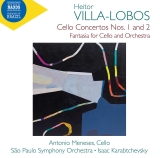Es mag erstaunen, dass ein Komponist sein kompositorisches Oeuvre für Orchester mit einem Cellokonzert beginnt. Doch dafür gibt es eine Erklärung.
Als Villa-Lobos (1887–1959) etwa sechs Jahre alt war, begann sein Vater, ein Amateurcellist, ihn auf einer umgebauten Bratsche im Cellospiel zu unterrichten und er wurde ein begabter Cellist. Sein erstes Cellokonzert war sein erstes großes Orchesterwerk und die Fantasia concertante war seine letzte dem Cello gewidmete Komposition.
Das erste Cellokonzert aus dem Jahre 1915 ist ein schwärmerisches Werk voller jugendlicher Energie, das sich noch an europäischer Musik orientiert. Für den brasilianischen Cellisten Aldo Parisot komponiert, ist das Cellokonzert Nr. 2 von 1953 typisch brasilianisch. Obwohl Villa-Lobos keine volkstümlichen Themen direkt zitiert, durchdringen volkstümliche Elemente und tänzerische Tanzrhythmen die Partitur. Angeblich suggeriert die Musik die Einsamkeit des Menschen im Angesicht der Weite der Natur.
Die höchst phantasievolle Fantasie wurde von Bernard Greenhouse in Auftrag gegeben, der den Cellopart bei der Uraufführung in der Town Hall, New York, im Dezember 1958 spielte.
Antonio Meneses und Dirigent Karabtchevsky gestalten die drei großartigen Werke sehr farbig und dynamisch. Meneses musiziert sehr feinfühlig und immer lebendig, und auch im unteren Register klingt sein Cello ausdrucksstark.
Der Cellist kann die dichte Orchestrierung in den drei Werken durchdringen, ohne das Instrument zu überfordern. Empfehlenswert!
It may seem surprising that a composer should begin his compositional oeuvre for orchestra with a cello concerto. But there is an explanation for this.
When Villa-Lobos (1887-1959) was about six years old, his father, an amateur cellist, began teaching him to play the cello on a converted viola, and he became a gifted cellist. His first cello concerto was his first major orchestral work, and the Fantasia concertante was his last composition dedicated to the cello.
The first cello concerto, written in 1915, is a rapturous work full of youthful energy, still inspired by European music. Composed for Brazilian cellist Aldo Parisot, the 1953 Cello Concerto No. 2 is typically Brazilian. Although Villa-Lobos does not quote folk themes directly, folk elements and dance-like dance rhythms permeate the score. Ostensibly, the music suggests man’s loneliness in the face of nature’s vastness.
The highly imaginative Fantasia was commissioned by Bernard Greenhouse, who played the cello part at the premiere at Town Hall, New York, in December 1958.
Antonio Meneses and conductor Karabtchevsky give these three magnificent works very colorful and dynamic performances. Meneses’ music-making is very sensitive and always lively, and even in the lower register his cello sounds expressive.
The cellist is able to penetrate the dense orchestration in the three works without overtaxing the instrument. Recommendable!






















